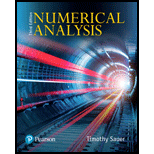
Concept explainers
Find the jacobian of the functions
a.
b.
c.
d.
a.
To find: The Jacobian of the function.
Answer to Problem 1E
TheJacobian of the function is
Explanation of Solution
Given information:
The given function is,
Concept used:
The Jacobian of the function is calculated as,
The given function is,
The Jacobian of the function is calculated as,
Substitute
Therefore, the Jacobian of the functionis
b.
To find: The Jacobian of the function.
Answer to Problem 1E
The Jacobian of the function is
Explanation of Solution
Given information:
The given function is,
Concept used:
The Jacobian of the function is calculated as,
The given function is,
The Jacobian of the function is calculated as,
Substitute
Therefore, the Jacobian of the function is
c.
To find: The Jacobian of the function.
Answer to Problem 1E
The Jacobian of the function is
Explanation of Solution
Given information:
The given function is,
Concept used:
The Jacobian of the function is calculated as,
The given function is,
The Jacobian of the function is calculated as,
Substitute
Therefore, the Jacobian of the function is
d.
To find: The Jacobian of the function.
Answer to Problem 1E
The Jacobian of the function is
Explanation of Solution
Given information:
The given function is,
Concept used:
The Jacobian of the function is calculated as,
The given function is,
The functions are,
The Jacobian of the function is calculated as,
Substitute
Therefore, the Jacobian of the function is
Want to see more full solutions like this?
Chapter 2 Solutions
Numerical Analysis
Additional Math Textbook Solutions
Pathways To Math Literacy (looseleaf)
Precalculus: A Unit Circle Approach (3rd Edition)
College Algebra (Collegiate Math)
Elementary Statistics
Precalculus
Elementary Statistics (13th Edition)
- DO NOT WANT AI SOLUTION. Thank Youarrow_forward1 2 5. Let S = 0 0 statements is true? and consider the subset W = {A Є M22 | SA = AS}. Which one of the following A. W is not a subspace of M22 = 4 B. W is a subspace of M22, and dim W C. W is a subspace of M22, and dim W = 3 D. W is a subspace of M22, and dim W = 2 E. W is a subspace of M22, and dim W = 1 F. W is a subspace of M22, and dim W = 0arrow_forward8. A large online retailer is analyzing how frequently their product WonderWidget™ is returned. Out of 345 Wonder Widgets bought, 48 were returned. (a) Find the 97% confidence interval for the long-run proportion of WonderWidgets returned. (b) If the retailer wanted to obtain a 97% confidence interval with a margin of error +0.03, how many purchases it should analyze?arrow_forward
- DO NOT WANT AI SOLUTION. Thank Youarrow_forwardBinomial probability problem: A new teaching method claims to improve student engagement. A survey reveals that 60% of students find this method engaging. If 10 students are randomly selected, what is the probability that: a) Exactly 7 students find the method engaging? b) At least 8 students find the method engaging? (please note that “at least 8” is different from 8) Question 1: Binomial probability of exactly 7 students (1 point) Question 2: Binomial probability of at least eight students (1 point)arrow_forwardA tablet computer has a 1 inch border of plastic around the screen. What is the area of the plastic border?arrow_forward
- Algebra & Trigonometry with Analytic GeometryAlgebraISBN:9781133382119Author:SwokowskiPublisher:Cengage
 College Algebra (MindTap Course List)AlgebraISBN:9781305652231Author:R. David Gustafson, Jeff HughesPublisher:Cengage Learning
College Algebra (MindTap Course List)AlgebraISBN:9781305652231Author:R. David Gustafson, Jeff HughesPublisher:Cengage Learning Elements Of Modern AlgebraAlgebraISBN:9781285463230Author:Gilbert, Linda, JimmiePublisher:Cengage Learning,
Elements Of Modern AlgebraAlgebraISBN:9781285463230Author:Gilbert, Linda, JimmiePublisher:Cengage Learning,


